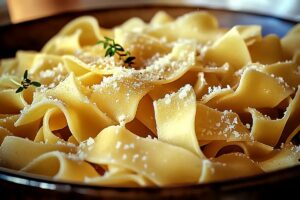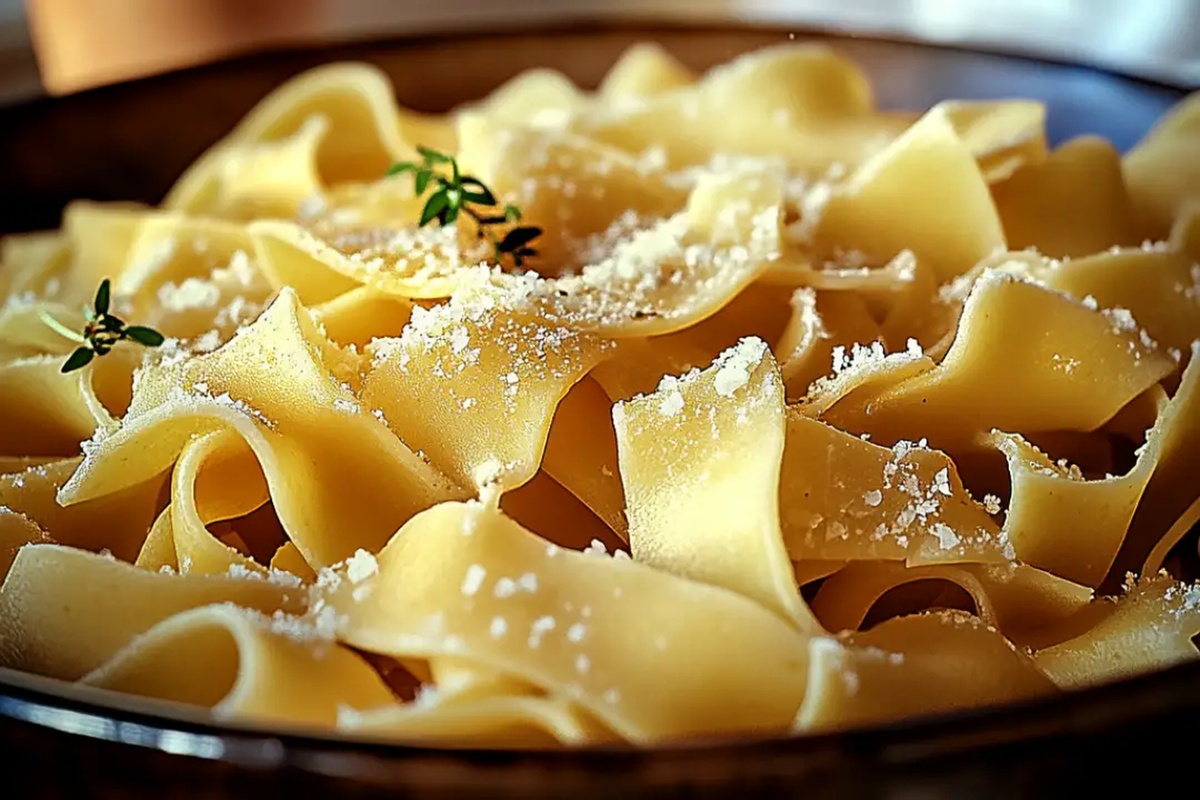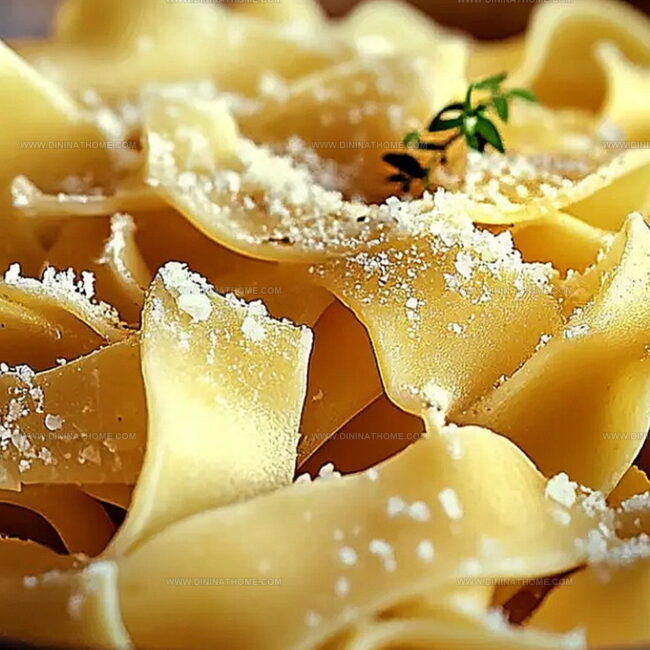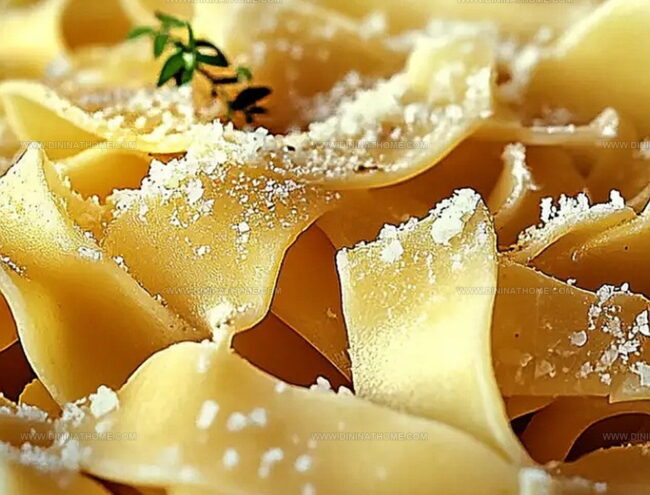The Quick and Simple Homemade Egg Noodles Recipe You’ll Love
My weekend culinary adventures always include experimenting with delightful homemade egg noodles that bring comfort and joy to my kitchen.
Pasta crafted from scratch offers unmatched texture and flavor compared to store-bought varieties.
Whisking eggs and flour becomes a meditative process that connects me to traditional cooking techniques.
Simple ingredients dance together, creating silky strands of pure deliciousness.
Fresh ingredients transform ordinary meals into memorable experiences that spark conversation around the dinner table.
Mastering these noodles unlocks a world of culinary creativity you can savor with every delectable bite.
Embrace the art of handmade pasta and watch your cooking skills soar to new heights.
Egg Noodles That Make Any Dish Feel Like Comfort Food
Quick Kitchen Mastery: Perfect for Home Cooks who want delicious, fresh pasta!
Ingredient List for Homemade Egg Noodles
Main Protein Base:Liquid Ingredients:Dry Ingredients:Homemade Egg Noodle Making Step-by-Step
Step 1: Whisk Eggs into Fluffy Clouds
Grab your eggs and whisk them vigorously until they transform into a light, airy mixture that looks like soft clouds.
The more you whisk, the more delicate your noodles will become.
Step 2: Create Silky Dough Mixture
Combine the whisked eggs with:Mix everything until a smooth, cohesive dough forms.
Knead the dough on a clean surface, working it until it becomes elastic and soft.
Step 3: Roll Out Delicate Pasta Sheets
Sprinkle your countertop with a generous dusting of flour.
Roll the dough using a rolling pin, stretching it to a thin, almost translucent layer approximately 1/8 inch thick.
Ensure the surface is evenly flattened.
Step 4: Transform Dough into Noodle Ribbons
Use a pizza cutter or sharp kitchen knife to slice the dough into long, elegant strips.
You can make them wide like pappardelle or thin like spaghetti, depending on your preference.
Step 5: Boil to Perfection
Fill a large pot with water and bring it to a rolling boil.
Gently drop the noodle strips into the bubbling water.
Cook for 7-9 minutes until they reach a tender, al dente texture.
Step 6: Preserve Your Homemade Treasure
After cooling, store your fresh noodles in an airtight container.
They’ll keep in the refrigerator for 2-3 days or can be frozen for 1-2 months, ready for your next culinary adventure.
Step 7: Serve with Culinary Creativity
Unleash your inner chef!
These noodles shine in hearty chicken soup, can be tossed with sauce, or served as a comforting side dish.
The possibilities are endless.
Egg Noodle Dough Tips for Homemade Comfort
Chill Homemade Egg Noodles for Later
What Goes with Homemade Egg Noodles
Egg Noodle Dough Adjustments
FAQs
Yes, you can easily make egg noodles by hand using a rolling pin and a sharp knife or pizza cutter. Roll the dough thin and cut into strips manually.
All-purpose flour is the most common and recommended flour for making egg noodles. It provides the right texture and structure for the dough.
The dough should feel smooth and elastic, not sticky or crumbly. When you press it, it should spring back slightly and hold together without falling apart.
Absolutely! You can incorporate dried herbs like parsley, basil, or garlic powder directly into the dough for extra flavor. Just mix them in with the flour before combining with wet ingredients.
Print
Homemade Egg Noodles Recipe
- Total Time: 20 minutes
- Yield: 4 1x
Description
Silky homemade egg noodles bring Italian comfort to kitchen counters, weaving culinary magic with simple ingredients. Delicate strands promise a nostalgic dining experience you’ll savor with each tender, freshly crafted bite.
Ingredients
Main Ingredients:
- 2 cups flour
- 1 egg
- 2 egg yolks
Liquid Ingredients:
- 3 tablespoons cold water
Seasoning:
- 1 teaspoon salt
Instructions
- Whisk eggs vigorously in a mixing bowl until they transform into a pale, airy mixture with a light, frothy texture.
- Introduce cold water and salt into the egg mixture, then gradually fold in flour until a cohesive dough forms. Knead the mixture energetically on a clean surface, working it until a smooth, elastic consistency develops.
- Dust a flat work area generously with flour to prevent sticking. Press and stretch the dough with a rolling pin, creating a thin, uniform sheet approximately 1/8 inch thick, ensuring even distribution.
- Select a pizza cutter or sharp culinary knife to slice the delicate dough into precise, uniform strips, maintaining consistent width for even cooking.
- Fill a large pot with water and bring to a rolling boil. Carefully lower the fresh noodle strips into the bubbling liquid, allowing them to cook for 7-9 minutes until they achieve a tender, al dente texture.
- For preservation, transfer cooled noodles to an airtight container. Refrigerate for short-term storage up to 2-3 days or freeze for extended preservation lasting 1-2 months.
- Elevate your culinary creation by serving these handcrafted noodles in a steaming chicken soup or as a versatile side dish complementing various main courses.
Notes
- Make eggs room temperature before beating to achieve maximum fluffiness and better dough consistency.
- Use a pasta machine or extra flour when rolling to prevent sticky dough and ensure thin, even noodles.
- Consider adding herbs like parsley or chives to the dough for enhanced flavor and a gourmet touch.
- Replace wheat flour with a blend of almond and rice flour for a celiac-friendly version.
- Prep Time: 10 minutes
- Cook Time: 10 minutes
- Category: Dinner, Lunch
- Method: Boiling
- Cuisine: Italian
Nutrition
- Serving Size: 4
- Calories: 225
- Sugar: 0 g
- Sodium: 190 mg
- Fat: 4.5 g
- Saturated Fat: 1.5 g
- Unsaturated Fat: 3 g
- Trans Fat: 0 g
- Carbohydrates: 42 g
- Fiber: 2 g
- Protein: 8 g
- Cholesterol: 90 mg





James Walker
Lead Recipe Developer & Culinary Educator
Expertise
Southern Cuisine & Farm-to-Table Cooking, Recipe Development & Testing, Culinary Education & Instruction
Education
School: Auguste Escoffier School of Culinary Arts
Program: Diploma in Culinary Arts and Operations
Focus: Comprehensive training in classical and modern culinary techniques, kitchen operations, and farm-to-table practices.
James didn’t learn cooking from a TV show, he learned it from busy kitchens, family gatherings, and long afternoons spent testing recipes the hard way.
After training at the Auguste Escoffier School of Culinary Arts, he brought his love for real, down-to-earth food to every dish he makes.
At Dining At Home, James loves building recipes that feel familiar but still have something special, like adding a twist to a classic or making a slow Sunday dinner feel brand new.
When he’s not in the kitchen, you’ll probably find him swapping garden tips at the farmers’ market or teaching his daughter how to flip pancakes without a mess (almost).